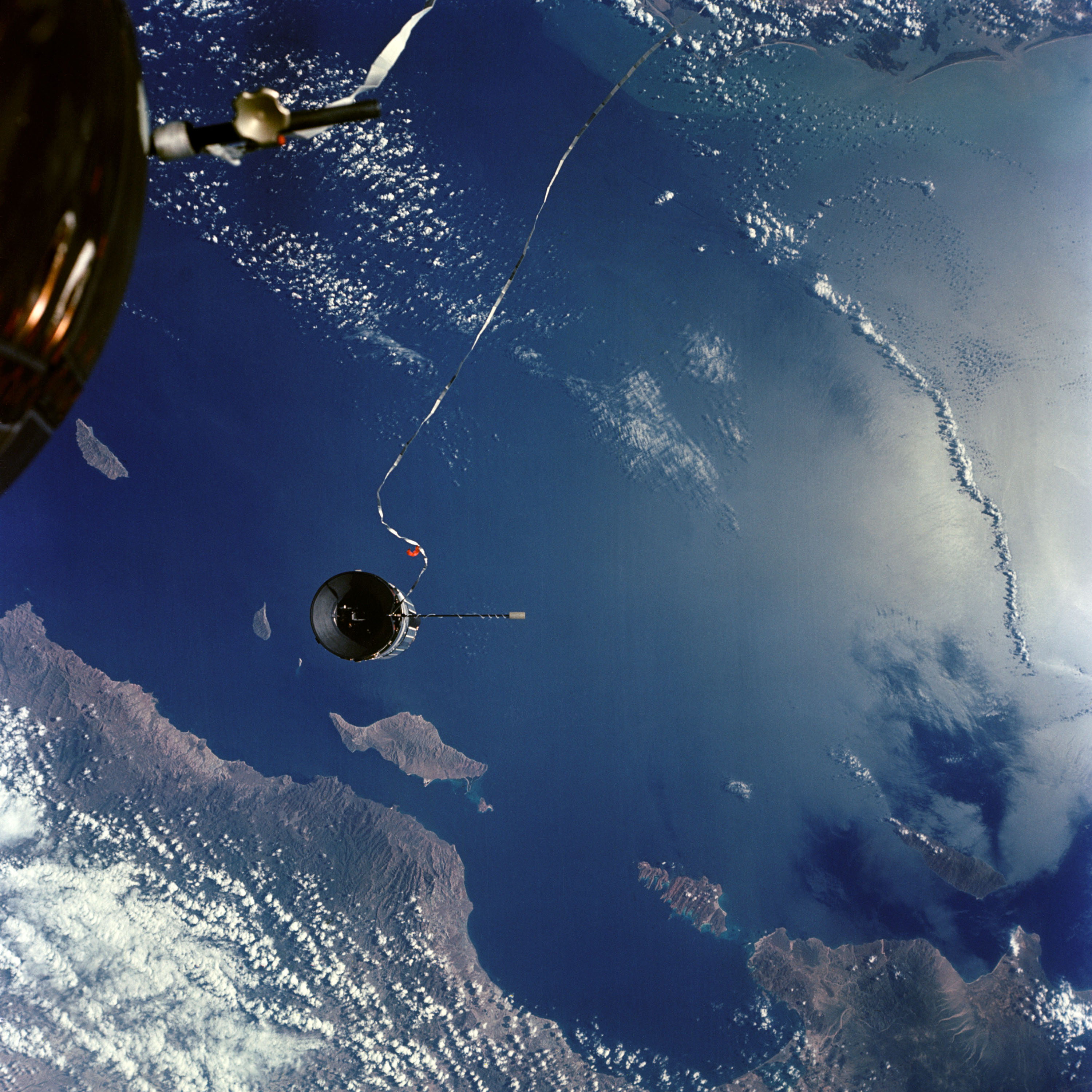
Half a century ago, this coming week, on 12 September 1966, Gemini XI astronauts Charles “Pete” Conrad and Dick Gordon launched from Earth within a two-second-long “window” and docked with an unmanned Agena target vehicle just 1.5 hours after launch, on their very first orbit of Earth. It was an astonishing achievement and one which mission planners lauded as critical in accomplishing Project Apollo’s mandate of Lunar Orbit Rendezvous (LOR). When the two astronauts docked with the Agena at 11:16 a.m. EDT, some 94 minutes after liftoff, their first task was to undock, then redock, to demonstrate the capability. With this test done, the astronauts settled down to an intensive three days in space. It would be three days of experiments, spacewalking, high-flying, and sheer drama.
As described in yesterday’s AmericaSpace history article, the high-altitude component of Gemini XI had been under discussion for many months, and on 14 September Conrad and Gordon completed it. The Agena’s main engine was fired to boost the combined ships to an altitude of 850 miles (1,370 km). With the exception of the Apollo missions to the Moon, this remains a world record for the highest Earth-orbital altitude ever achieved by any astronaut or cosmonaut.
By this time, Gordon had also completed an ambitious spacewalk on 13 September. However, during the final preparations, the two astronauts realized that they needed much less time than anticipated to prepare their suits and equipment. Although Gordon would be performing the Extravehicular Activity (EVA), the procedures required the cabin to be reduced to vacuum and thus demanded that Conrad be fully-suited, too. At length, they hooked up Gordon’s environmental support system and conducted several oxygen-flow checks, which proved to be a mistake because it dumped oxygen into the cabin and its excess was then vented into space. They could not afford such a rate of oxygen loss, and Conrad told Gordon to switch back to Gemini XI’s systems. By this point, Gordon had gotten uncomfortably warm.
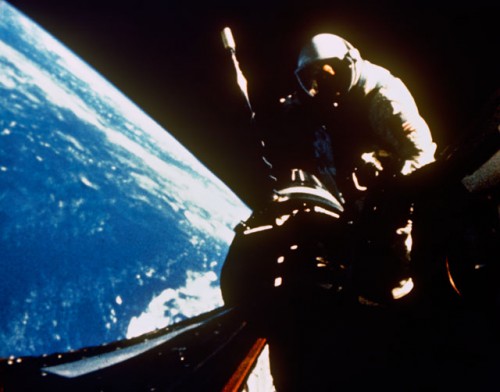
The main problem, wrote fellow astronaut Buzz Aldrin, actually lay in Conrad and Gordon’s impatience in skipping through the formal, six-page, hundred-plus-step sequence of donning and preparing their equipment. “As a result,” Aldrin related in his 1989 book, Men from Earth, “they upset cabin pressurization when they checked out Gordon’s oxygen umbilical and he became overheated long before his EVA began.”
The men considered asking Flight Director Cliff Charlesworth to let Gordon begin his EVA one orbit early, but due to issues with tracking and lighting decided to stick with the schedule, a decision that they would come to regret. As they prepared to fit Gordon’s dark sun visor onto his helmet, it proved a stubborn chore; Conrad eventually fastened one side, but could not reach over to snap the other side in place, leaving Gordon hot, bothered and in need of rest. After struggling for a few more minutes, Gordon eventually snapped the right side in place—cracking the sun visor in the process—and was thoroughly winded by the time he cranked open the hatch and stood on his seat at 9:44 a.m. EDT.
Instantly, Gordon’s exit into space was accompanied by everything else inside the cabin that was not tied down. Standing on his seat, his first activity was to deploy a handrail—a fairly easy task—after which he removed a nuclear emulsion package from outside the spacecraft and passed it in to Conrad, who stuffed it into his foot well. Next, Gordon tried to install a camera in a bracket to photograph his own movements, but this proved difficult. To resolve it, Conrad released enough of the umbilical slide through his gloved hand to let Gordon float above the camera, thump it with his fist, and secure it in place.
The spacewalker’s next task was to attach a 100-foot (30-meter) Dacron tether, housed in the Agena’s docking collar, onto Gemini XI’s nose. As Gordon pushed himself forward, he missed his goal and drifted in an arcing path above the adaptor and around in a semi-circle, until he reached the back of the spacecraft. However, Conrad had released only a couple of feet of the 28-foot (9-meter) umbilical, so he pulled Gordon back to the hatch to start again. At length, Gordon reached the target and grabbed some handrails to pull himself astride the docking collar—prompting Conrad to yell “Ride ’em, cowboy!”—but the exercise proved more difficult in space than it had in ground tests. In space, he found himself constantly fighting against his suit to keep himself from floating away—a situation rendered all the more difficult by the lack of any kind of “saddle” to help him. All he could do was hold on with one hand and try to operate the tether clamp with the other.
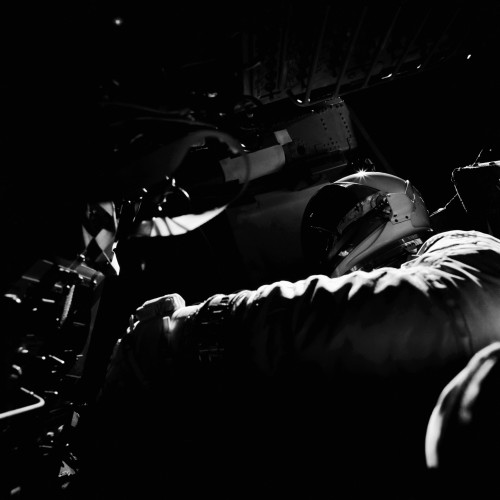
He struggled vigorously, finally securing the line and setting the stage for the tethered flight experiment which would come later in the mission. Yet it was clear to Conrad that Gordon was encountering severe difficulties, and the differences between EVA practice in terrestrial conditions and the real thing were profound: the spacewalker, soaked with sweat and eyes stinging, was reduced to groping his way blindly around.
As Gordon neared the hatch, Conrad helped as much as he could, discussing procedures for getting to the spacecraft adaptor to store his compressed-gas zip-gun. It was obvious, though, that Gordon was exhausted: when they passed next over the Tananarive tracking station, Conrad told Capcom John Young that he had “brought Dick back in; he got so hot and sweaty, he couldn’t see.” Unlike Gene Cernan, however, Gordon had no trouble whatsoever getting back inside Gemini XI or closing the hatch. Disappointingly, the spacewalk had lasted just 33 of its intended 107 minutes, and one of its key tasks—a power tool evaluation which had evaded Dave Scott on Gemini VIII—was lost.
Gordon’s exhaustion did not disrupt the remainder of the mission. Flight planners had learned to schedule periods of less-vigorous activity immediately after heavy work, and the astronauts’ next task involved leisurely repacking equipment and restoring some semblance of order to the cabin. Additionally, communications with Mission Control dwindled to little more than short transmissions about spacecraft systems and medical checks, which gave them much-needed respite. Conrad test-fired a sluggish thruster, and the men ate a meal and photographed the atmospheric airglow.
These moments of relatively quiet time would not last. Ahead of them lay the so-called “high ride”—their Agena-assisted climb to a record-breaking altitude of 850 miles (1,370 km). To prepare themselves, they donned their suits, closed their visors, and secured as much cabin equipment as possible, as if in readiness for re-entry, and focused their attention on the Agena. Forty hours after Gemini XI’s launch, at 2:12 a.m. EDT on 14 September, Conrad fired the Agena’s engine for 26 seconds. Both men were electrified by the burn. “Whoop-de-doo!” Conrad yelled. “[That’s] the biggest thrill of my life!”
Beneath them, the men beheld the intense and striking blues of the oceans, the sprinkling of clouds, and the astonishing clarity of Africa, India, and Australia. “Looking straight down,” he radioed, “you can see just as clearly. There’s no loss of color and details are extremely good.” To cope with the adverse radiation effects of the Van Allen belts, Gemini XI’s high-apogee orbits were timed to take place over Australia, where levels were calculated to be relatively low. “Sounds like it’s safer up there than a chest X-ray,” said Capcom Al Bean at one stage. It was at this altitude—the highest yet attained by humanity—that the flight’s imaging experiments, notably the synoptic terrain and weather photography objectives, produced stunning results. In total, Conrad and Gordon clicked more than 300 exposures, and their descriptions of the sheer clarity of the eastern hemisphere filled principal investigators with excitement and anticipation.
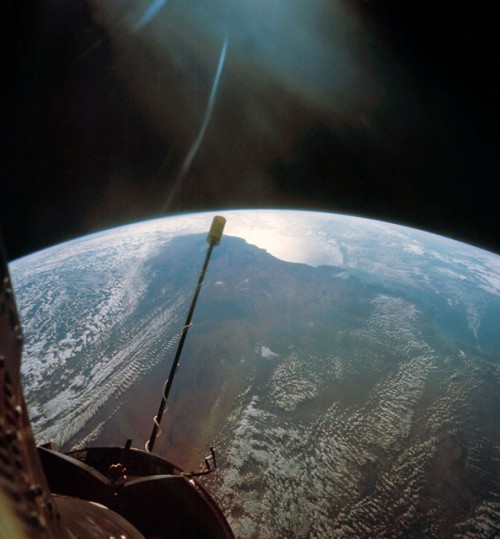
Not until Apollo 8’s voyage to the Moon in December 1968 would humans travel to higher altitudes, and, almost five decades later, Conrad and Gordon retain the record for the highest-ever Earth orbit attained by humans. “As the coupled craft soar toward their record apogee,” Time magazine told its readers a week after Gemini XI’s splashdown, “the curvature of the Earth’s horizon becomes more pronounced and the Earth assumes an unmistakably globelike shape. Though the pictures are sharp and show geological features plainly, the Earth seems devoid of life; it offers no visible evidence of its teeming population, its great cities, its bridges or its dams.”
Two orbits later, on their 26th revolution, as Gemini XI passed over the United States, Conrad again fired the Agena’s engine to lower their apogee to about 160 miles (290 km). After a bite to eat, Gordon opened his hatch, high above Madagascar, for his second EVA. This time, he stood on the “floor” of Gemini XI, poked his helmeted head outside and watched the sunset. Secured by a short tether, he could at least use both hands to mount cameras easily in their brackets and remained “outside” for no less than two full hours. “Most enjoyable” was his summary of the stand-up EVA and, indeed, flight surgeons commented that from the biosensor data, it was uneventful.
Their next step was the tethered vehicle exercise, which could be attempted by two different means. One of these assumed the position of a “pole,” always pointing toward Earth’s center—a so-called “gravity-gradient” attitude—in which Conrad and Gordon would have backed their spacecraft out of the Agena’s docking cone slowly until the tether became taut. If properly positioned, a slight thrust would have kept the tether taut and the joined “pole” would have drifted serenely around the globe, each spacecraft maintaining the same relative position and attitude. Should this have been unsuccessful, the men were tasked with trying a “spin-up,” or “rotating,” mode. In this case, after physical undocking Conrad would fire Gemini XI’s thrusters to induce a rotation of one degree per second and, as the tethered pair circled Earth, their mutual centre-of-gravity would lie at a specific point on the tether, around which they would do a slow, continuous cartwheel.
Over Hawaii, Conrad and Gordon separated from the Agena and began the cautious attempt to begin the gravity gradient demonstration. There was enough initial tension in the tether to upset the target and cause the Gemini to move toward the Agena’s docking adaptor and Conrad quickly adjusted his motion. Then, as he backed away, the tether stuck, probably in the stowage container, when just 50 feet (15 meters) had been released. Conrad pulsed the thrusters to free the tether, but it quickly became hung up on a patch of Velcro and he was forced to shift Gemini XI out of vertical alignment to peel the tether off the Velcro pad. This disturbed the Agena again and there still remained about 10 feet (3 meters) of tether to be pulled out.
On the ground, engineers began to worry. The Agena should have taken around seven minutes to stabilize itself; when it took longer, they began to suspect that something was wrong with its attitude-control system and opted to abandon the gravity gradient attempt and adopt the “spin-up” mode instead. However, when Conrad tried to initiate the rotation, another problem arose when he could not get the tether taut; it seemed to rotate counter-clockwise. “This tether’s doing something I never thought it would do,” he told Capcom John Young. “It’s like the Agena and I have a skip rope between us and it’s rotating and making a big loop. Man, have we got a weird phenomenon going on here!”
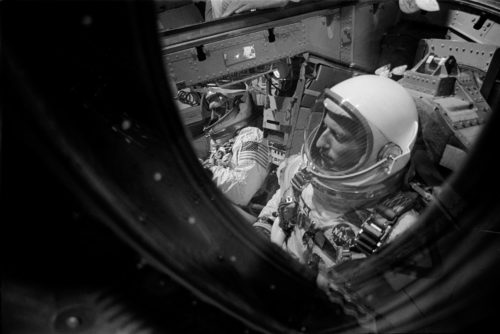
Although the spinning line was curved, it also had tension, and for several minutes Conrad and Gordon jockeyed Gemini XI’s thrusters to straighten the arc. Eventually, the tether straightened and became taut and Conrad rolled the spacecraft and fired the thrusters to begin the slow cartwheeling motion. At first, it seemed that he had stretched the tether, which had a big loop in it, but steadily, as both astronauts gritted their teeth, centrifugal force took over and it smoothed out. A 38-degree-per-minute rotation rate was obtained and remained steady throughout a night orbital pass.
Moving into dawn, they were asked by the Hawaii capcom to accelerate their spin-up rate and, with some reluctance, Conrad agreed. Suddenly, Gordon shouted “Oh, look at the slack! It’s going to jerk this thing to heck!” When the added acceleration started, the tether tightened, then relaxed, causing a “slingshot” effect which seesawed both astronauts up to 60 degrees in pitch. In response, Conrad steadied the spacecraft and, to his surprise, the Agena stabilized itself. Their rotation rate checked out at 55 degrees per minute and they were able to test for a tiny amount of artificial gravity: When they placed a camera against Gemini XI’s instrument panel and let go, it moved in a straight line to the rear of the cockpit and parallel to the direction of the tether. Neither of the astronauts, however, felt any physiological effect of gravity. After three hours of docked operations, they jettisoned Gemini XI’s docking bar and pulled away.
Despite understandable disappointment that the gravity gradient technique could not be fully demonstrated, the spin-up mode at least proved that station-keeping could be done economically. After undocking, Conrad originally intended to decrease his spacecraft’s speed, allowing him to pull ahead of the Agena, but was advised instead to prepare for a “coincident-orbit” rendezvous, whereby he would follow the target in its exact orbital path. This would demonstrate their ability to station-keep at very long range with little fuel usage. As a result of the plan change, Gemini XI’s separation maneuver was adjusted; instead of a retrograde firing, Conrad and Gordon “added” speed and height to their orbit, such that Agena-XI passed “beneath” and in front of them. Next, they fired their thrusters to place themselves in the same (coincident) orbit as the Agena, trailing it. Three-quarters of a revolution around Earth, Conrad decreased his “forward” speed and, as expected, Gemini XI dropped into the Agena’s orbital lane, 20 miles (32 km) behind it, with no relative velocity between the pair.
Turning their attention back to the Agena, they asked ground controllers how far they were from the target and were advised that their distance remained 20 miles (32 km), closing very slowly. A second rendezvous, beginning early on 15 September, was near-perfect: Conrad tilted Gemini XI’s nose 53 degrees above level flight and fired the forward thrusters. This placed them in a lower orbit than the Agena, ready to catch up with it, and they took some time to tend to their experiments. An hour later, Conrad fired the aft thrusters to raise his spacecraft’s orbit, then began to brake Gemini XI until he finally reported that he was on-station and steady with the target once more. Twelve minutes later, they executed a separation burn from the Agena for the final time. By this stage, the success had been so great that they could afford to be jocular; Conrad even asking Flight Director Glynn Lunney to send up a tanker to refuel them for more rendezvous.
The ambitious mission came to a close with a fully automatic re-entry; unlike previous returns, in which the command pilots had flown their spacecraft down from 70 miles using the Gemini’s offset center-of-gravity to provide lift for changes in direction, Conrad would not use his hand controller in conjunction with computer directions. At 8:24 a.m. EDT on 15 September 1966, partway through their 44th orbit, the retrorockets fired. Conrad disengaged his hand controller and put the system onto autopilot. This performed admirably and Gemini XI splashed down safely within six miles of the helicopter carrier U.S.S. Guam at 8:59 a.m. Their mission left only one more Gemini flight and cleared another hurdle for humanity’s first piloted foray to the Moon.
This is part of a series of history articles, which will appear each weekend, barring any major news stories. Next week’s article will focus on the 25th anniversary of STS-48, a September 199 shuttle flight which launched the Upper Atmosphere Research Satellite (UARS).
Want to keep up-to-date with all things space? Be sure to “Like” AmericaSpace on Facebook and follow us on Twitter: @AmericaSpace




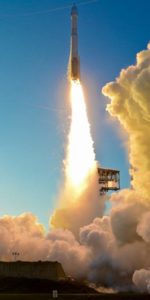
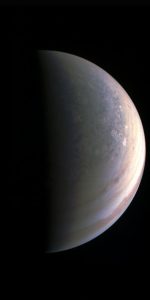
I’m so Glad I was alive and Watched and Listened to these missions ( and most were supplied by my school St Patrick’s in Fall River, Massachusetts )..Just an Amazing time for a young Space Fan…Thank you for these stories…..
Richard Gordon joins the exclusive group of astronauts who have celebrated the 50th anniversary of his/her spaceflight. Congratulations, Dick!
I was once a space cadet kid and read whatever I could find about NASA and Space Exploration.
In those days we had a NASA led Mercury-Gemini-Apollo national space program that was clearly focused on our nation’s needs and interests. And that NASA led space program was understandable to most folks.
What do kids and adults see today?
Do they see the President cancelled the quite doable NASA Constellation Moon Program and replaced it with endless nonscientific and not credible public relations Mars Soon NASA noise?
“Constellation began in response to the goals laid out in the Vision for Space Exploration under NASA Administrator Sean O’Keefe.[4][5] O’Keefe’s successor, Michael D. Griffin, ordered a complete review, termed the Exploration Systems Architecture Study, which reshaped how NASA would pursue the goals laid out in the Vision for Space Exploration, and its findings were formalized by the NASA Authorization Act of 2005. The Act directed NASA to ‘develop a sustained human presence on the Moon, including a robust precursor program to promote exploration, science, commerce and US preeminence in space, and as a stepping stone to future exploration of Mars and other destinations.'”
And, “NASA lists a number of reasons for a human return to the Moon on its website:[33]
to extend human colonization,
to further pursue scientific activities intrinsic to the Moon,
to test new technologies, systems, flight operations and techniques to serve future space exploration missions,
to provide a challenging, shared and peaceful activity to unite nations in pursuit of common objectives,
to expand the economic sphere while conducting research activities that benefit our home planet,
to engage the public and students to help develop the high-technology workforce that will be required to address the challenges of tomorrow.”
From: ‘Constellation program’ at: Wikipedia
For what compelling national security reason or logic did the current President cancel the NASA human Lunar surface Constellation program? Was it because the nearby Moon was too expensive for NASA missions, but obviously highly risky, super costly, and very long duration voyages in the high radiation environment of Deep Space going to and from far distant Mars was a more affordable and cheaper deal? Even a kid can figure out that such confused ‘Presidential logic’ is far beyond being credible with Congress or anyone who thinks about it for two seconds.
And after the NASA human Lunar surface Constellation program was supposedly cancelled, why did Congress pass a law which the President signed that requires NASA to lead international human Lunar surface missions?
See: PUBLIC LAW 111–267—OCT. 11, 2010
At: http://www.nasa.gov/pdf/516655main_PL_111-267.pdf
What is the real reason the President doesn’t want NASA led international human missions to the Lunar surface? And why does PUBLIC LAW 111–267—OCT. 11, 2010 that requires those international human Lunar surface missions continue to be ignored by the President despite his signature on that NASA human Lunar mission space law?
Was it simply a another classic version of ‘He or she who pays gets to play’?
Was it just an unfortunate case of, ‘No money, or not enough money, from the Constellation program folks, well that means no American gets to work, live, and play on the Moon’?
Consider:
‘WikiLeaks’ Guccifer 2.0: Obama Sold Off Public Offices to Donors Corruption doesn’t start or end with Hillary’ By Michael Sainato 09/14/16
At: http://observer.com/2016/09/wikileaks-guccifer-2-0-obama-sold-off-public-offices-to-donors/
If today a kid or an adult wants to go to work, live, and play on the Moon, does he or she end up wisely concluding that buying an ‘anointed’ Lunar government job from an American President is his or her highest priority?
What a ‘wonderful gift’ of legalized corruption we give to the next generations of space cadet kids and adults around the world.
“Half a century ago, this coming week, on 12 September 1966, Gemini XI astronauts Charles ‘Pete’ Conrad and Dick Gordon launched from Earth within a two-second-long ‘window’ and docked with an unmanned Agena target vehicle just 1.5 hours after launch, on their very first orbit of Earth. It was an astonishing achievement and one which mission planners lauded as critical in accomplishing Project Apollo’s mandate of Lunar Orbit Rendezvous (LOR).”
So what could we Earthlings do, or start to do, with the Moon in the next half century? Or what could we do within the next 84 years, a period of time which will be well within the lifespan of many of the world’s babies?
What did we know in 1974 about the Moon and is it a good clue as to what we could possibly do next in space?
“THE tenuous nature of the lunar atmosphere is maintained by rapid loss of gases released at the lunar surface. But would such rapid loss still occur if the density of the lunar atmosphere were greatly increased from its present value? Here I seek to answer this question by evaluating quantitatively the atmospheric loss mechanisms operating in the lunar environment. One conclusion is that if the density of the lunar atmosphere is increased, a point can be reached where loss occurs so slowly that it is negligible over human time scales (that is, exponential decay lifetimes are greater than hundreds of years). So the present lunar ‘vacuum’ is a fragile state that should be treated carefully if it is to be preserved or could be modified if so desired.”
From: ‘Creation of an artificial lunar atmosphere’ By RICHARD R. VONDRAK Department of Space Physics and Astronomy, Rice University, Houston, Texas
Nature 248, 657 – 659 (19 April 1974); doi:10.1038/248657a0
At: http://www.nature.com/nature/journal/v248/n5450/abs/248657a0.html
“When it comes to remaking a celestial body in Earth’s image—’terraforming’ it—the moon has clear advantages: It gets twice the sunlight of Mars. It’s a three-day trip with current technology, while getting people to Mars would take six months. Furthermore, the moon is dead and it’s small, so it needs less work and investment to build an atmosphere. Mars has slightly less than the total area of Earth’s dry land; the moon has a quarter of it—a bit smaller than all Asia.”
From: “How to Terraform the Moon It’ll be habitable, if a lot like Florida.”
By Gregory Benford July 14, 2014
At: http://www.slate.com/articles/technology/future_tense/2014/07/terraforming_the_moon_it_would_be_a_lot_like_florida.html
Yep, a thick Lunar atmosphere could offer effective shielding against Galactic Cosmic Radiation and small meteoroids. That could make a lot of things quite doable on the Moon.
Over 4,000,000,000 folks live in Asia and maybe just as many could someday live on the Moon if it had a nice thick atmosphere like the Earth’s.
Building up the Moon’s atmosphere and population while tapping Lunar resources might even keep us busy enough that our squabbling here on Earth about resources and other issues could be minimized.
Wow! Not squabbling so much could save us Earthlings a lot of money and help us avoid a big bunch of misery, and such a golden opportunity might even create all kinds of win-win situations for also developing the Earth, Cislunar Space, Mars, and Ceres.
That could mean lots of fun for everyone!
We space cadets need to connect with and help the real world we live in and quit spouting Mars Soon fantasies. Developing the Moon can decrease the risks and costs of developing the rest of Cislunar Space and Cislunar Space is quite valuable and useful for the efficient and sustainable development of the planet Earth where most folks live and pay taxes.
“To be honest, in the minds of the vast majority rational folks who work hard every day to feed their families, better roads to cut their commuting times are far more likely to be seen as having an effect on their lives than some rocket to another planet. And yet the space people have big parties that they invite one another to.
This must have been what it was like when Rome was burning.”
From: ‘What It Was Like When Rome Was Burning’ By Keith Cowing on September 14, 2016
At: http://www.nasawatch.com/
“JIUQUAN, Sept. 15 (Xinhua) — China has acquired the basic technology to carry out manned lunar missions, chief engineer of China’s manned space program Zhou Jianping said Thursday.”
And, “China’s space station and cargo spacecraft will be launched at the Wenchang launch site, Zhou said, adding that from a technical perspective it is better to carry out manned lunar missions at the Wenchang site.”
From: ‘China acquires basic technology for manned lunar missions: chief engineer’
Source: Xinhua 2016-09-16 01:04:55
At: http://news.xinhuanet.com/english/2016-09/16/c_135689902.htm
It is good to know that some folks are still interested in, and want to go to, the Moon.